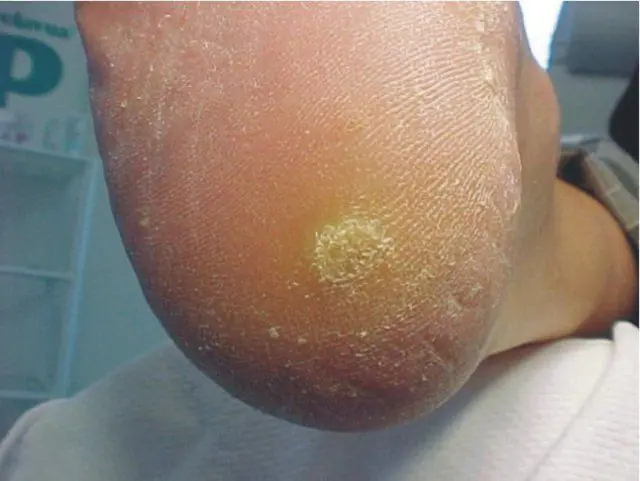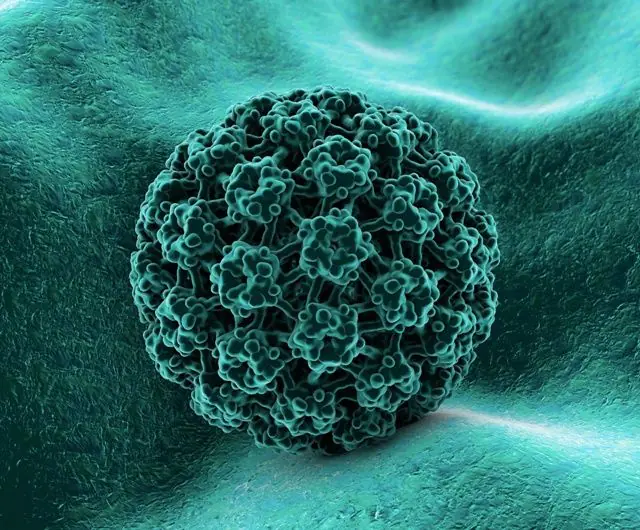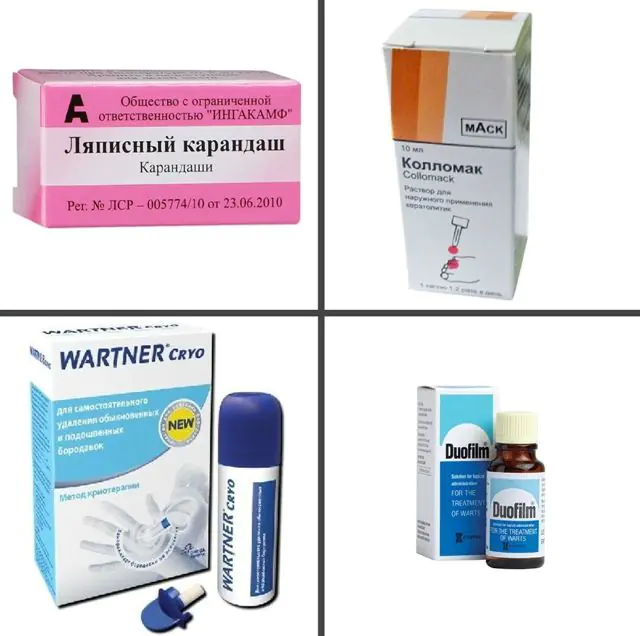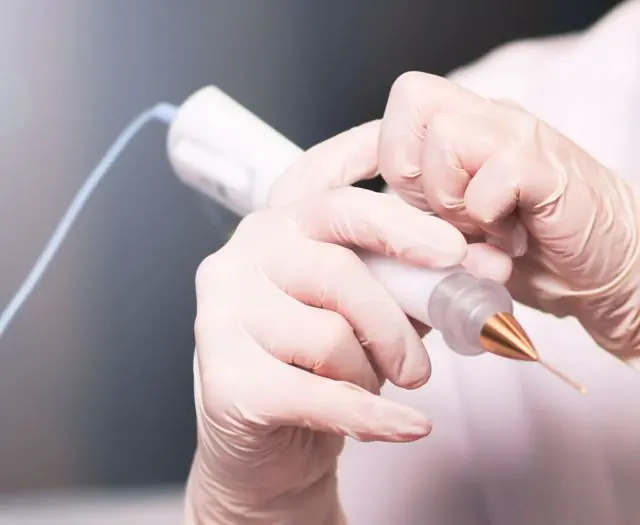
- What do dry warts look like?
- Reasons for appearance
- Treatment options
- Folk remedies
- Medicines
- Removal of the tumor
A dry wart is a small lump on the skin that resembles a callus. It causes severe discomfort, especially when located on the foot, and therefore requires urgent treatment. Here you can go several ways - use medical and folk remedies, or choose one of the available physiotherapeutic techniques. Their features are described below, as well as the appearance of such neoplasms and the reasons for their appearance.
What do dry warts look like?

Photo of dry warts
Dry warts are called so because of their appearance, as they have a scaly and ulcerated surface. Accordingly, most often the integrity of the growth is broken and it consists of several layers located on top of each other. However, despite their name, the neoplasms may well ooze a clear or whitish liquid, similar in consistency to jelly.
A dry wart on the toe is more like a callus; it almost never rises above the skin, lying close to it. In most cases, the growths are even pressed into the tissue due to the high loads on the foot while walking.
One of the main symptoms of a dry wart is severe discomfort and pain, which becomes even more noticeable when there is excessive pressure on the formation.
In most cases, a dry wart appears in a single copy and has considerable dimensions - on average about 1 cm. Its diameter can increase with constant mechanical impact on the formation and due to the active activity of the papilloma virus.
Dry warts on the body have a round shape and ragged, uneven edges with a whitish tint. Mostly their surface is pink, flesh or brown. Sometimes black and red inclusions can be observed inside. The latter are the result of drying of blood, which appears as a result of a violation of the integrity of the formation.
Such neoplasms can be located both on the foot and in the toe area, but rarely appear in the middle of the foot. Unlike other types of growths, a dry wart on a finger or toe almost never spreads to other areas of the body. But it also cannot go away on its own, like, for example, a simple type of growth.
Next to dry warts, the skin sometimes becomes inflamed and red, and itching is often bothersome. Scratching problem areas often leads to bleeding and increases the risk of infection.
- See also symptoms of dry warts on the legs
Causes of growths on the foot

A dry wart on the leg appears due to infection of the body by the papilloma virus and activation of the pathogen. It builds up its strength approximately 3-12 months after penetration. However, several years may pass before the formation appears, or it may not grow at all. But for this, the immune system must be strong enough and give HPV a worthy rebuff.
Among the secondary reasons for the appearance of dry warts on the leg, the following should be noted:
- Excessive sweating. Under such conditions, HPV actively develops and quietly infects healthy cells. This is especially true for patients with hyperhidrosis and diabetes. This also threatens people who wear tight shoes in the warm season, due to which the skin cannot “breathe” normally.
- Rare foot treatment. Dry white warts can occur if your feet are not washed often enough, and this should be done with antibacterial soap. This allows you to neutralize all dangerous microorganisms on the surface and prevent them from penetrating inside. This cleaning is especially important in the summer when it is very hot outside.
- Infrequent shoe washing. Periodically, not only the outside, but also the inside of shoes, boots, etc. must be wiped with a damp cloth with powder or soap. This will remove dangerous microorganisms from the surface and protect against their penetration through microcracks, which are almost always present on the skin of the feet. In this case, those who complain of excessive sweating of the feet are especially likely to suffer from dry warts.
- Rare change of hosiery. During wear, they become dirty and damp, which contributes to the spread and activation of the papilloma virus. This is especially likely for those who sweat a lot.
- Uncomfortable shoes. Wearing it leads to rubbing of the skin and the appearance of calluses, which, when bursting, cause a violation of the integrity of the tissue. These wounds are the “entry gate” for the papilloma virus, which, penetrating inside the body, infects healthy cells and starts the process of forming a dry wart, and not only on the foot.
The papilloma virus can be transmitted in two ways - household contact and sexual contact. In the first case, we are talking about the use of things of an infected person, and in the second we mean the penetration of HPV into the body during coitus. At the same time, its shape does not play a special role; the threat remains during both vaginal and anal sexual contact.
The papilloma virus can also be transmitted through poorly sterilized instruments along with blood, saliva, and lymph. Sometimes this happens at an appointment with a cosmetologist, dentist, or gynecologist. This also becomes possible when doing a manicure, tattooing, or ear piercing.
Activation of the papilloma virus and the appearance of dry warts on the arms, legs, etc. Poor ecology, active treatment with antibacterial drugs, gastroenterological and otolaryngological diseases also contribute.
This can also happen due to poor nutrition, leading to the development of vitamin deficiency. Hormonal imbalance, bad habits, an inactive lifestyle, and stressful situations also have a certain influence on this.
Methods for treating dry warts
First, you can try folk remedies, among which it is worth highlighting solutions, decoctions, vegetable juices and oils. All this can be used to treat formations, prepare compresses and baths. If this approach does not give the desired results, you will need to use pharmaceutical ointments, creams, and gels.
Folk remedies

You can rub a dry wart on your face, hands, or feet with lemon juice, which, however, is not suitable for treating sensitive skin. The optimal frequency of such procedures is 3 times a day. In total, treatment should last 2-4 weeks. Instead of this product, you can use the juice of garlic, onions, aloe, potatoes or celandine.
Here's how and what you can use to remove a dry wart:
- Oils. Sea buckthorn, which has strong cleansing properties, is best suited here. It is recommended to warm it up before use. Next, you need to moisten a cotton pad with the composition and wipe the growth. This must be done for 10-15 days. As an analogue to this remedy, you can use eucalyptus, rosemary, tea tree, olive, and coconut oil.
- Decoctions. The best way to remove dry warts is a wormwood-based product made from this herb in dried form (2 tsp) and warm water (300 ml). Let it sit on low heat for about 5 minutes, cool and strain. Soak a cotton pad in the purified liquid and treat the formation. You should do this 3 times a day for at least one week.
- Solutions. The best solution is to prepare a product from baking soda (2 tsp) and boiling water (200 ml). It must be infused for about 20 minutes. Then you should lower your feet there and wait 10 minutes. This bath should be taken at least every other day and preferably in the evening, before bed. As an alternative to soda, you can use finely ground sea salt. It is also recommended to remove dry warts with apple cider vinegar, rubbing them 2-3 times a day for 2 weeks.
It is also quite effective to wipe the growths with damp laundry soap, which dries them well and promotes the appearance of a scab.
Medicines

Pictured are medications for dry warts
When fighting a dry wart on the leg, Wartner Cryo is useful. To cauterize formations, you need to insert the applicator into a special connector and fix it on the affected area for 40 seconds.
In addition, you can treat the growth with a lapis pencil, which costs about 130 rubles. (60 UAH). This should be done twice a day for 2 weeks.
Also, there will be no trace of dry warts on the body if you use Collomac. To remove them, formations must be treated 2 times a day for 10 days. Its cost is about 600 rubles. (270 UAH). As a replacement, you can use Duofilm, available at a price of 900 rubles. (420 UAH).
There are also many effective solutions for eliminating dry warts on the leg. One of them is Verrucacid, which needs to be applied to the affected areas only 1-3 times. It can be purchased at a price of 200 rubles. (90 UAH). It has an equally effective analogue - Feresol, and it costs only 40 rubles. (190 UAH).
To suppress the papilloma virus at the local level, it is recommended to use an effective remedy for dry warts “Oxolin” or Salicylic ointment. Their price is approximately 60 rubles. (25 UAH). Both products must be applied 2-3 times a day, treatment can last from 10 to 15 days.
Also relevant will be the gel “Viferon” at a price of 500 rubles. (220 UAH), which, if necessary, can be replaced with Clareol. They should be used twice a day, the duration of effective therapy is on average 2 weeks.
For dry warts, a special patch, for example, Formu Clear, is very helpful in treatment. It must be glued to the formation and left for a day. After this time, the remedy should be changed, and this should be done until the course is completed for 1-2 weeks. After removing the patch, it is recommended to clean the skin with a scraper. You can buy it at a price of 120 rubles. (50 UAH).
For those who are somehow planning to treat dry warts on the legs, special creams like Aldara, which sells for 3,000 rubles, will not be superfluous. (1400 UAH). It is recommended to apply this product to eliminate formation 3-4 times a week. It can be replaced with Vartek at the same cost. In total, treatment usually lasts from 10 to 20 days.
Removal of the tumor

To eliminate dry formation, surgical excision is most effective. However, this method is relevant only if the person after surgery can afford not to put any weight on the leg for some time. Otherwise, it is better to use safer physiotherapeutic methods.
Let's look at methods for removing dry warts:
- Cryotherapy. This procedure is carried out by applying liquid nitrogen to the affected area. With its help, it is possible to freeze problem cells and start the process of their destruction. This happens on average within a few weeks, and 1-2 sessions are usually sufficient. This technique is considered non-invasive and safe, does not require rehabilitation and is affordable; the price of cryodestruction is 360 rubles (150 hryvnia).
- Radiocoagulation. This technique involves exposing the affected areas to special waves. They carefully move the tissues apart and excise the formation without injuring them. Thanks to the gentle effect, the risk of blood and infection is eliminated, and the recovery time of the skin is reduced. The price of radio destruction is 3,000 rubles (1,200 hryvnia).
- Electrocoagulation. To carry out this procedure, problem areas are treated with electric current, which can be either low or high frequency. It helps to form a crust, with the removal of which the dry wart itself disappears. As a result, there is no scar left and the risk of a new formation is reduced to almost zero. This technique is safe and painless. The price of electrocoagulation is 590 rubles (250 hryvnia).
- Laser therapy. In this case, we mean eliminating the growth using a special laser. It heats the formation and “evaporates”. To completely eliminate a wart, 1-2 such procedures are enough. The features of this technique are that it is painless and versatile; it is suitable for removing warts of any size and depth. The session duration ranges from 20 to 30 minutes, the price of laser therapy is 2900 rubles (1300 hryvnia).
When trying to understand how to get rid of dry warts, it is worth considering all possible methods - traditional, medical, physiotherapeutic. But before choosing the appropriate technique, you must consult with your doctor and, if necessary, conduct a thorough examination. Only an integrated approach to solving such a problem will solve it without much difficulty!
- Related article: Which doctor treats warts on the feet



